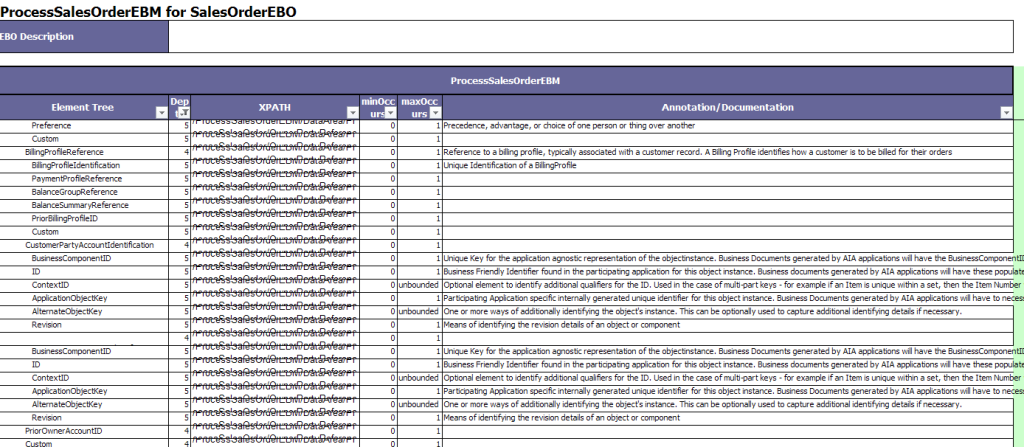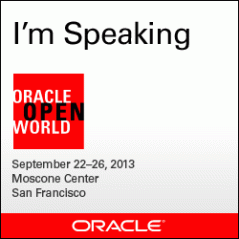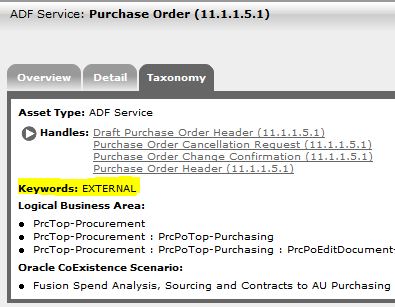One of the joys of working in product development, especially in my earlier customer success advocate role, is the satisfaction received when helping resolve customers needs with your products!
A few months back, a key telecom customer needed to describe the semantic Enterprise Business Object (EBO) structure in a hierarchical/indented model to a flat spreadsheet so that designers can perform application mapping for the Process Integration Packs (a.k.a. PIP, basically pre-packaged integration accelerators for specific business process flows). I pointed them to a not-well publicised (and highly underestimated tool) called the XSL Mapping Analyzer (a.k.a XMAN).
Below is an email from the customer describing how useful they found the tool, in fact just one of the utilities! Thanks to the OCS Team (Balaji S G and Kurt) and KT (Sungwoo Yu) for this valuable feedback!
Side note: XMAN is actually a set of utilities my team built to parse XSL and EBO XSDs into various formats for semantic analysis of attribute level mapping; including HTML, CSV, flattened CSV and XML. It’s real power is in providing tactical SOA governance if you are using AIA canonicals, as it can help flag functional interoperability issues across projects using the same EBO, thereby encouraging service reuse and providing the ROI on your SOA. To learn more about XMAN usage, see my earlier blog post and OOW 2009 session.
— Email below published verbatim with prior owner’s permission —
Hi Balaji,
I’m glad to share my experience with Rajesh’ blog
Specially, I use to visit and learn a best practices using aia from that popular blog.
I’d like to briefly introduce my situation.
I’m working at telecom Project aims to build next generation BSS/OSS for 35 mil subscribers utilized by Oracle RODOD(Siebel,BRM,OSM, OPH and etc) .
I’m in charge of Integration team.
As we try to fit OOTB PIPs with our business, we need to analysis OOTB PIPs and design extension of PIPs.
These days our team cooperation with OCS for Communication PIP extension design on AIA Technical Document Design.
Although we cannot totally understand what existing input/output message and mapping in complex process integrations, we have to provide explain how prebuilt aia integration build interoperability with Siebel, BRM.
Basically, we can refer PIP implementation documents. However, if we closely looked at message level input/output and mapping details for reviewing service detail communication with edge application. It had been challenge.
At that time, I concerned that below so that I requested the OCS guidance
For we describe edge ABM structure or complex EBMs on spreadsheet, how can we describe different level elements on spreadsheet automatically?
Why we need to describe on spreadsheet, most of edge application function designer is not familiar with complex related xsd and different level of structure specially ebo.
So, when designed for extension of pips, Edge application function designer is unable to consider EBO structure.
If AIA team share used each operation EBM by spreadsheet, they will be easy to approach understanding EBO
Do you have any idea for that?
1. How to automatically convert message structure xsd to table. (It could be different structure distinguished by indentation)
2. If we describe different level elements distinguish using XPath, How we automatically extract XPath of all nodes from EBM.
Thanks to OCS(Balaji, Kurt) helps
We can utilize AIA Development Tools such as XMAN, XSD Flatter and generated XMAN reports RV11.1.
Particularly, XSD Flatter is right to solve above two problems.
For instance, I’m going to explain how I can extract element tree on spreadsheet from SalesOrderEBM.xsd
source $AIA_INSTANCE/bin/aiaenv.sh.
cd $AIA_Installed Directory/DeveloperTools/XSDFlattener/bin/
xsd2csv.sh -inputSchemaURL $AIA_Metadata_Directory /AIAComponents/EnterpriseObjectLibrary/Industry/Communications/EBO/SalesOrder/V2/SalesOrderEBO.xsd -rootElement ProcessSalesOrderEBM
As converted, I’ve got a csv file with x-path, cardinality, annotation and element tree with display hierarchy using indentation, and then reformatted below.

Even, I can convert ABM of Siebel Integration Object Message as well.
xsd2csv.sh -inputSchemaURL $AIA_Metadata_Directory /AIAComponents/ApplicationObjectLibrary/Siebel/V1/schemas/SWIOrderIO.xsd -rootElement ListOfSWIOrderIO

In addition, I aware generated RV11.1 XMAN report already provided whole EBM csv information by support.oracle.com
Also I can generate csv report from all of EBM using eol2csv.
eol2csv.sh -inputDir $AIA_Metadata_Directory /AIAComponents/ApplicationObjectLibrary/Siebel/V1/schemas -outputDir ~/eoloutput/AIAComponents/ApplicationObjectLibrary/Siebel/V1/schemas
Thanks
Sungwoo




 As described in the paper, these services are used by customers/partners to extend and integrate with Oracle Fusion Applications, whether in on-premise or SaaS mode. This post describes the keyword in detail by addressing five frequently asked questions.
As described in the paper, these services are used by customers/partners to extend and integrate with Oracle Fusion Applications, whether in on-premise or SaaS mode. This post describes the keyword in detail by addressing five frequently asked questions. The topology splits visibility to web and service resources into two categories – internal and external. This is achieved by fronting all HTTP requests through two different Oracle HTTP Servers (OHS), one for internal traffic routed between Fusion Applications servers, and another for external sources, which has only a small subset of the routing rules to prevent unauthorized access by external systems. This approach facilitates unhindered access within the Fusion Applications domain and acts as a firewall to restrict access to external systems.
The topology splits visibility to web and service resources into two categories – internal and external. This is achieved by fronting all HTTP requests through two different Oracle HTTP Servers (OHS), one for internal traffic routed between Fusion Applications servers, and another for external sources, which has only a small subset of the routing rules to prevent unauthorized access by external systems. This approach facilitates unhindered access within the Fusion Applications domain and acts as a firewall to restrict access to external systems. IMPORTANT NOTE: This is a simple text search and will result in services that have the word EXTERNAL in any metadata, including descriptions. Therefore, you may get false positives. To confirm the service accessibility, always check the Keyword value on the Taxonomy tab of the service detail page as shown in the screenshot at the top of this post.
IMPORTANT NOTE: This is a simple text search and will result in services that have the word EXTERNAL in any metadata, including descriptions. Therefore, you may get false positives. To confirm the service accessibility, always check the Keyword value on the Taxonomy tab of the service detail page as shown in the screenshot at the top of this post.